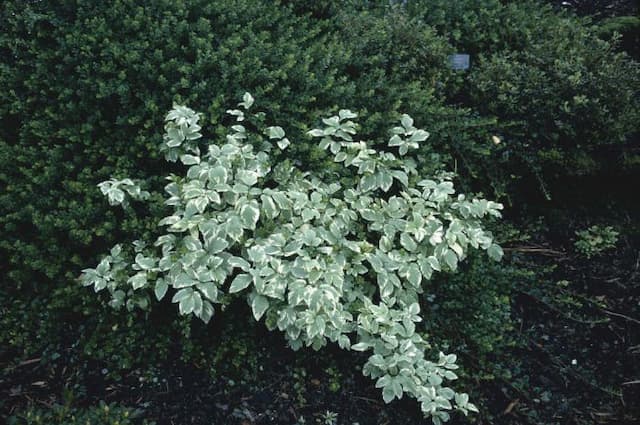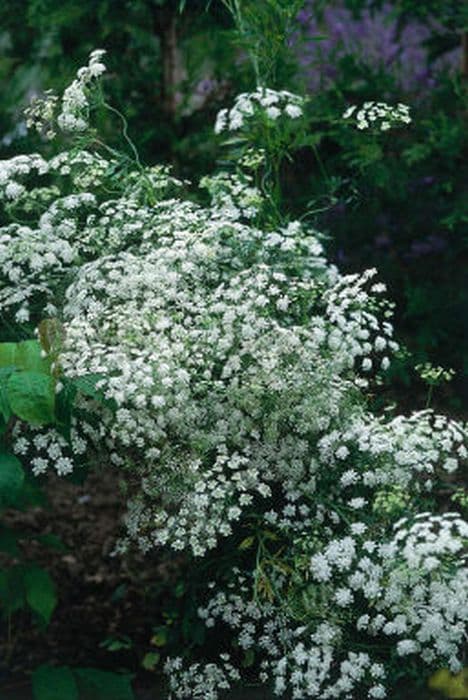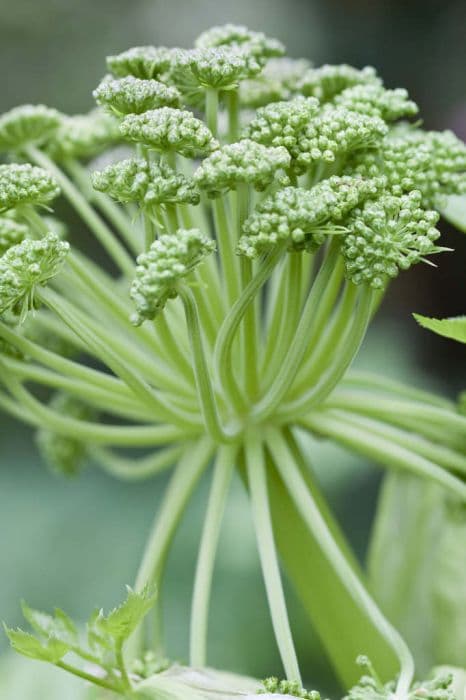Masterwort 'Abbey Road' Astrantia major 'Abbey Road' (PBR)

ABOUT
'Abbey Road' is a clump-forming perennial to 80cm tall with deeply divided, coarsely-toothed dark green leaves. Upright, dark coloured stems bear umbels of deep reddish-purple flowers with white bases and surrounded by prominent bracts in summer
About this plant
 Names
NamesFamily
Apiaceae
Synonyms
Great Masterwort, Hattie's Pincushion, Masterwort
Common names
Astrantia major 'Abbey Road' (PBR).
 Characteristics
CharacteristicsLife cycle
Perennials
Foliage type
Deciduous
Color of leaves
Green
Flower color
Dark red
Height
2 feet (60 cm)
Spread
2 feet (60 cm)
Plant type
Herb
Hardiness zones
5
Native area
Europe
Benefits
 General Benefits
General Benefits- Ornamental Appeal: Adds visual interest to gardens with its unique star-shaped, pincushion-like flowers and striking deep purple coloring.
- Long Blooming Season: Provides a prolonged display of blooms from June to August, enhancing garden aesthetics for much of the summer.
- Attracts Pollinators: Invites beneficial pollinators such as bees and butterflies, promoting biodiversity in the garden.
- Low Maintenance: Requires minimal upkeep once established, making it a convenient choice for gardeners of all skill levels.
- Drought Tolerance: Once established, it is relatively drought-tolerant, reducing the need for frequent watering.
- Cut Flower Garden Addition: Flowers are well-suited for use in bouquets and arrangements, adding beauty both indoors and out.
- Rabbit Resistant: Naturally resistant to rabbits, which helps prevent damage and maintains the plant's visual appeal.
- Deer Resistant: Less palatable to deer, offering a degree of protection in areas where deer browsing can be a problem for gardeners.
- Shade Tolerance: Capable of thriving in partially shaded areas, providing flexibility in garden placement and landscape design.
- Cold Hardy: Demonstrates a good level of cold hardiness, allowing it to survive and flourish in cooler climates.
 Medical Properties
Medical PropertiesThis plant is not used for medical purposes.
 Air-purifying Qualities
Air-purifying QualitiesThis plant is not specifically known for air purifying qualities.
 Other Uses
Other Uses- Astrantia major 'Abbey Road' can be used in flower arrangements to provide unique texture and interest due to its pincushion-like flower heads.
- As a companion plant in the vegetable garden, Astrantia major 'Abbey Road' may attract predatory insects such as lacewings and hoverflies that feed on common pests.
- With its tolerance to damp conditions, Astrantia major 'Abbey Road' can be planted along stream banks or in rain gardens to help stabilize soil and manage water runoff.
- These plants can be used in educational gardens to demonstrate the concept of 'plant breeding' to students, showing new varieties like 'Abbey Road' that are developed from native species.
- Astrantia major 'Abbey Road' is suitable for creating naturalistic or wild garden designs that require minimal maintenance and contribute to biodiversity.
- The long last quality of Astrantia flowers when cut makes them a sustainable option for dried floral crafts and decorations.
- In cottage garden designs, Astrantia major 'Abbey Road' adds a traditional look and can help create a sense of history and continuity in the landscape.
- The plant can be used in moon gardens where its flowers might catch the moonlight and add an element of nighttime visual interest for garden enthusiasts.
- Astrantia major 'Abbey Road' can be utilized in sensory gardens due to its textural flowers and attractive foliage, offering a tactile experience.
- For photographers and artists, the complex structure of Astrantia flowers can serve as an intriguing subject for macro photography and botanical illustration.
Interesting Facts
 Feng Shui
Feng ShuiThe Masterwort is not used in Feng Shui practice.
 Zodiac Sign Compitability
Zodiac Sign CompitabilityThe Masterwort is not used in astrology practice.
 Plant Symbolism
Plant Symbolism- Complexity and Diversity: The intricate details and numerous florets of Astrantia major, commonly known as Great Masterwort, symbolize the multifaceted nature of life and the beauty inherent in diversity.
- Grace and Elegance: With its delicate, pincushion-like flowers, the Great Masterwort represents a sense of sophistication and refined beauty.
- Mystery and Secretiveness: Often found in shaded areas, the flower has a secretive aura that can allude to the mysteries and unknown depths of the human soul.
- Protection: The sturdy and resilient nature of the Great Masterwort is sometimes used to symbolize strength and a protective shield against harm.
 Water
WaterThe Great Masterwort (Astrantia major 'Abbey Road') requires regular watering to maintain consistently moist soil, especially during dry spells. In general, water the plant deeply once a week with about 1 gallon of water per plant, ensuring that you are not just wetting the surface but soaking the soil to reach the roots. During hot weather or periods of drought, you may need to water twice a week. Always check the soil moisture before watering, as overwatering can be as harmful as underwatering. Reduce watering frequency as the plant becomes established and in cooler months to prevent waterlogging.
 Light
LightThe Great Masterwort thrives best in partial shade to full sun, preferring a spot that gets morning sun and afternoon shade or dappled sunlight throughout the day. Avoid placing it in an area with harsh, direct afternoon sun, especially in hotter climates, as this can scorch the leaves and stress the plant.
 Temperature
TemperatureGreat Masterwort is cold hardy and can tolerate temperatures down to about 0 degrees Fahrenheit, making it suitable for growing in many climates. The ideal temperature range for the Great Masterwort is generally between 60 and 75 degrees Fahrenheit. It's a hardy perennial and can withstand cold winters, but should be protected from extreme heat and frost.
 Pruning
PruningThe Great Masterwort should be pruned to remove spent flowers and encourage further blooming. Prune the plant after the first flush of flowers has faded, typically in midsummer. Cut the stems back by about half to promote a second bloom period. Additionally, in late fall or early spring, cut back dead foliage to maintain a tidy appearance and encourage healthy growth.
 Cleaning
CleaningAs needed
 Soil
SoilGreat masterwort requires a soil mix with good drainage, rich in organic matter, preferably garden loam mixed with compost and some grit or perlite to improve drainage. The soil pH for optimal growth should be neutral to slightly alkaline, around 7.0.
 Repotting
RepottingGreat masterwort does not require frequent repotting and can typically be done every 2-3 years or when the plant becomes root-bound.
 Humidity & Misting
Humidity & MistingGreat masterwort prefers moderate to high humidity levels but is quite adaptable and can tolerate lower humidity typical of outdoor garden settings.
 Suitable locations
Suitable locationsIndoor
Place in bright, indirect light with moist, well-drained soil.
Outdoor
Grow in partial shade or sun, in fertile, moist soil.
Hardiness zone
4-7 USDA
 Life cycle
Life cycleAstrantia major 'Abbey Road', commonly known as Great Masterwort, initiates its life cycle as a seed which, when sown, germinates in a damp, cool environment, typically in spring. After germination, the seedling establishes itself, developing a rosette of leaves at ground level and roots that anchor into the soil and absorb nutrients. In the first few years, it grows vegetatively, forming a clump with its deeply lobed, dark green leaves and begins to develop its robust root system. As a perennial, after the establishment phase, Astrantia major 'Abbey Road' enters the flowering stage, producing tall stems topped with pincushion-like inflorescences surrounded by petal-like bracts in summer. After blooming, the flowers may develop into seed heads if pollination is successful, and as the growing season ends, the plant may die back at the surface level while the roots remain dormant through the winter. With the return of favorable conditions in spring, Astrantia major 'Abbey Road' regrows from its rootstock, continuing its life cycle for several years before it may eventually require division or succumb to age or environmental stresses.
 Propogation
PropogationPropogation time
Spring to early summer
One of the most popular methods of propagating Astrantia major 'Abbey Road', commonly known as Great Masterwort, is by division. This is best done in the spring as the new growth appears. To propagate by division, carefully lift the plant from the soil and gently separate the crown into smaller sections, each with a portion of the root system attached. It is important to make sure that each division has at least one growing point. The divisions can then be immediately replanted into well-prepared soil, spaced about 15 to 18 inches apart (approximately 38 to 45 centimeters). Water thoroughly after planting to establish the new divisions. This method of propagation ensures that the new plants will be true to the parent plant, as it is a form of vegetative reproduction.









